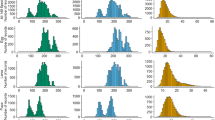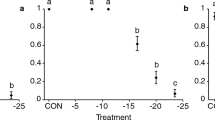Abstract
The energy and nutrient demands of parasites on their hosts are frequently invoked as an explanation for negative impacts of parasitism on host survival and reproductive success. Although cuterebrid bot flies are among the physically largest and most-studied insect parasites of mammals, the only study conducted on metabolic consequences of bot fly parasitism revealed a surprisingly small effect of bot flies on host metabolism. Here we test the prediction that bot fly parasitism increases the resting metabolic rate (RMR) of free-ranging eastern chipmunks (Tamias striatus), particularly in juveniles who have not previously encountered parasites and have to allocate energy to growth. We found no effect of bot fly parasitism on adults. In juveniles, however, we found that RMR strongly increased with the number of bot fly larvae hosted. For a subset of 12 juveniles during a year where parasite prevalence was particularly high, we also compared the RMR before versus during the peak of bot fly prevalence, allowing each individual to act as its own control. Each bot fly larva resulted in a ~7.6% increase in the RMR of its host while reducing juvenile growth rates. Finally, bot fly parasitism at the juvenile stage was positively correlated with adult stage RMR, suggesting persistent effects of bot flies on RMR. This study is the first to show an important effect of bot fly parasitism on the metabolism and growth of a wild mammal. Our work highlights the importance of studying cost of parasitism over multiple years in natural settings, as negative effects on hosts are more likely to emerge in periods of high energetic demand (e.g. growing juveniles) and/or in harsh environmental conditions (e.g. low food availability).


Similar content being viewed by others
References
Bennett GF (1955) Studies on Cuterebra emasculator Fitch 1856 (Diptera: Cuterebridae) and a discussion of the status of the genus Cephenemyia Ltr. 1818. Can J Zool 33:75–98
Bennett GF (1972) Further studies on the chipmunk warble, Cuterebra emasculator (Diptera: Cuterebridae). Can J Zool 50:861–864
Boonstra R, Krebs CJ, Beacham TD (1980) Impact of botfly parasitism on Microtus townsendii populations. Can J Zool 58:1683–1692
Burns CE, Goodwin BJ, Ostfeld RS (2005) A prescription for longer life? Bot fly parasitism of the white-footed mouse. Ecology 86:753–761
Careau V, Thomas D, Humphries MM, Réale D (2008) Energy metabolism and animal personality. Oikos 117:641–653
Catts EP (1982) Biology of new world bot flies: Cuterebridae. Annu Rev Entomol 27:313–338
Clough GC (1965) Physiological effect of botfly parasitism on meadow voles. Ecology 46:344–346
Cramer MJ, Cameron GN (2006) Effects of bot fly (Cuterebra fontinella) parasitism on a population of white-footed mice (Peromyscus leucopus). J Mamm 87:1103–1111
Criscuolo F, Monaghan P, Nasir L, Metcalfe NB (2008) Early nutrition and phenotypic development: ‘catch-up’ growth leads to elevated metabolic rate in adulthood. Proc R Soc Lond B 275:1565–1570
Degen AA (2006) Effect of macroparasites on the energy budget of small mammals. In: Morand S, Krasnov BR, Poulin R (eds) Micromammals and macroparasites: from evolutionary ecology to management. Springer, Tokyo
Devevey G, Niculita-Hirzel H, Biollaz F, Yvon C, Chapuisat M, Christe P (2008) Developmental, metabolic and immunological costs of flea infestation in the common vole. Funct Ecol 22:1091–1098
Hawlena H, Abramsky Z, Krasnov BR (2005) Age-biased parasitism and density-dependent distribution of fleas (Siphonaptera) on a desert rodent. Oecologia 146:200–208
Hawlena H, Abramsky Z, Krasnov BR (2006a) Ectoparasites and age-dependent survival in a desert rodent. Oecologia 148:30–39
Hawlena H, Khokhlova IS, Abramsky Z, Krasnov BR (2006b) Age, intensity of infestation by flea parasites and body mass loss in a rodent host. Parasitology 133:187–193
Hawlena H, Krasnov BR, Abramsky Z, Khokhlova IS, Saltz D, Kam M, Tamir A, Degen AA (2006c) Flea infestation and energy requirements of rodent hosts: are there general rules? Funct Ecol 20:1028–1036
Humphries MM, Thomas DW, Hall CL, Speakman JR, Kramer DL (2002) The energetics of autumn mast hoarding in eastern chipmunks. Oecologia 133:30–37
Hunter DM, Webster JM (1974) Effects of cuterebrid larval parasitism on deer-mouse metabolism. Can J Zool 52:209–217
Khokhlova IS, Krasnov BR, Kam M, Burdelova NI, Degen AA (2002) Energy cost of ectoparasitism: the flea Xenopsylla ramesis on the desert gerbil Gerbillus dasyurus. J Zool 258:349–354
Koteja P (1996) Measuring energy metabolism with open-flow respirometric systems: which design to choose? Funct Ecol 10:675–677
Krasnov BR, Morand S, Hawlena H, Khokhlova IS, Shenbrot GI (2005) Sex-biased parasitism, seasonality and sexual size dimorphism in desert rodents. Oecologia 146:209–217
Landry-Cuerrier M, Munro D, Thomas DW, Humphries MH (2008) Climate and resource determinants of fundamental and realized metabolic niches of hibernating chipmunks. Ecology 89:3306–3316
Lee KA (2006) Linking immune defenses and life history at the levels of the individual and the species. Integr Comp Biol 46:1000–1015
Lemaître J, Fortin D, Montiglio PO, Darveau M (2009) Bot fly parasitism of the red-backed vole: host survival, infection risk, and population growth. Oecologia 159:283–294
Lessells CM, Boag PT (1987) Unrepeatable repeatabilities: a common mistake. Auk 104:116–121
Lighton JRB, Brownell PH, Joos B, Turner RJ (2001) Low metabolic rate in scorpions: Implications for population biomass and cannibalism. J Exp Biol 204:607–613
Lindström J (1999) Early development and fitness in birds and mammals. Trends Ecol Evol 14:343–348
Lochmiller RL, Deerenberg C (2000) Trade-offs in evolutionary immunology: just what is the cost of immunity? Oikos 88:87–98
Martin LB, Weil ZM, Nelson RJ (2008) Seasonal changes in vertebrate immune activity: mediation by physiological trade-offs. Phil Trans R Soc Lond B 363:321–339
McKinney TD, Christian JJ (1970) Incidence and effects of botfly parasitism in the eastern chipmunk. J Wildl Dis 6:140–143
McNab BK (2002) The physiological ecology of vertebrates: a view from energetics. Cornell University Press, Ithaca
Munger JC, Karasov WH (1994) Costs of bot fly infection in white footed mice: energy and mass flow. Can J Zool 72:166–173
Munro D, Thomas DW, Humphries MM (2008) Extreme suppression of above-ground activity by a food-storing hibernator, the eastern chipmunk (Tamias striatus). Can J Zool 86:364–370
Nespolo RF, Bacigalupe LD, Bozinovic F (2003) The influence of heat increment of feeding on basal metabolic rate in Phyllotis darwini (Muridae). Comp Biochem Physiol A 134:141–147
Payne JA, Cosgrove GE (1966) Tissue changes following Cuterebra infestation in rodents. Am Midl Nat 75:205–213
R Development Core Team (2006) R: A language and environment for statistical computing. R Foundation for Statistical Computing, Vienna
Scantlebury M, Waterman JM, Hillegass M, Speakman JR, Bennett NC (2007) Energetic costs of parasitism in the cape ground squirrel Xerus inauris. Proc R Soc Lond B 274:2169–2177
Selman C, Lumsden S, Bunger L, Hill WG, Speakman JR (2001) Resting metabolic rate and morphology in mice (Mus musculus) selected for high and low food intake. J Exp Biol 204:777–784
Slansky F (2007) Insect/mammal associations: effects of cuterebrid bot fly parasites on their hosts. Annu Rev Entomol 52:17–36
Smith DH (1978) Effects of bot fly (Cuterebra) parasitism on activity patterns of Peromyscus maniculatus in the laboratory. J Wildl Dis 14:28–39
Stearns SC (1992) The evolution of life histories. Oxford University Press, Oxford
Timm RM, Cook EF (1979) The effect of bot fly larvae on reproduction in white-footed mice, Peromyscus leucopus. Am Midl Nat 101:211–217
Wang L, Hudson J (1971) Temperature regulation in normothermic and hibernating eastern chipmunk. Comp Biochem Physiol A 31:59–90
Withers PC (1977) Measurements of VO2, VCO2 and evaporative water loss with a flow-through mask. J Appl Physiol 42:120–123
Acknowledgments
We thank J. P. Boyer, M. Descôteaux, R. Morin, and all field assistants who have helped to collect the data presented in this paper and to P. Bourgault for help with data management. We are grateful to M. Odiere, M. Scott, three anonymous reviewers, and especially P. Koteja for helpful comments on earlier drafts of this manuscript. This research was supported by a Québec FQRNT team grant, NSERC discovery grants to D. T. and M. M. H., and a NSERC doctoral scholarship to V. C. Animals were captured and handled with compliance to the Canadian Council on Animal Care (no. 2007-DT01-Université de Sherbrooke) and the Ministère des Ressources Naturelles et de la Faune du Québec (no. 2008-04-15-101-05-S-F). We are grateful to the Ruiter Valley Land Trust for allowing us to conduct this research within their boundaries.
Author information
Authors and Affiliations
Corresponding author
Additional information
Communicated by Pawel Koteja.
Rights and permissions
About this article
Cite this article
Careau, V., Thomas, D.W. & Humphries, M.M. Energetic cost of bot fly parasitism in free-ranging eastern chipmunks. Oecologia 162, 303–312 (2010). https://doi.org/10.1007/s00442-009-1466-y
Received:
Accepted:
Published:
Issue Date:
DOI: https://doi.org/10.1007/s00442-009-1466-y




